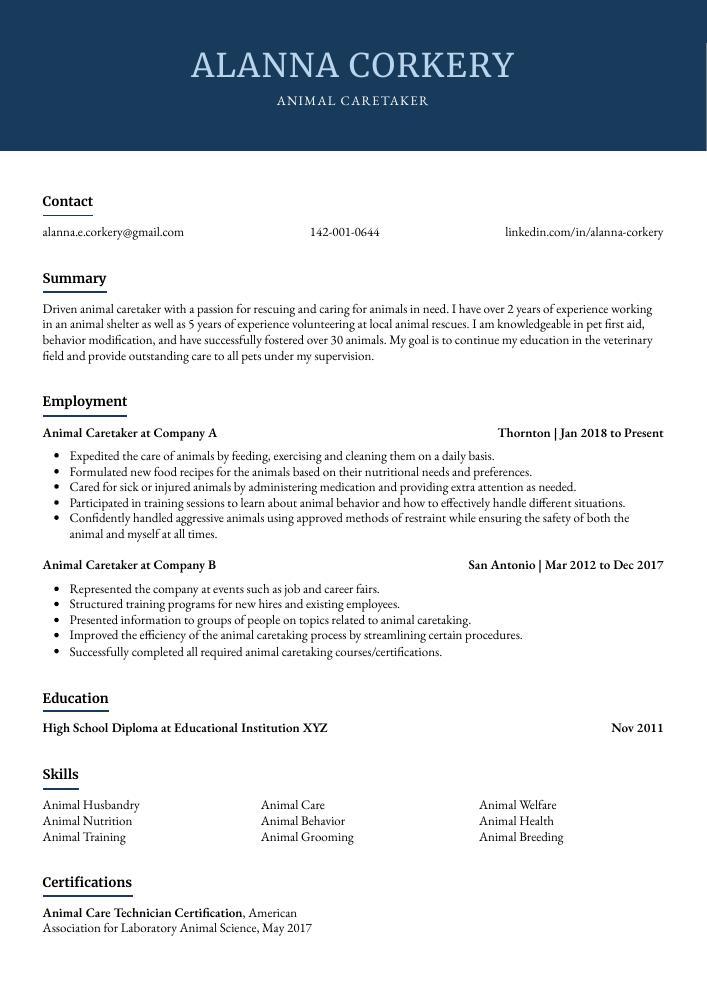Animal Caretaker Resume Guide
Animal caretakers work with a variety of animals and are responsible for their daily care. This includes feeding, cleaning, and exercising the animals. They also monitor the health of the animals and provide them with any necessary medical treatment. Animal caretakers must be able to handle all types of animals in a safe and humane manner.
You have a true passion for animals and would make an excellent caretaker at any animal shelter or rescue. However, employers in the animal care industry don’t know who you are or what you can do. To get their attention, you must put together a resume that highlights your skills and experience.
This guide will walk you through the entire process of creating a top-notch resume. We first show you a complete example and then break down what each resume section should look like.
Table of Contents
The guide is divided into sections for your convenience. You can read it from beginning to end or use the table of contents below to jump to a specific part.
Animal Caretaker Resume Sample
Alanna Corkery
Animal Caretaker
alanna.e.corkery@gmail.com
142-001-0644
linkedin.com/in/alanna-corkery
Summary
Driven animal caretaker with a passion for rescuing and caring for animals in need. I have over 2 years of experience working in an animal shelter as well as 5 years of experience volunteering at local animal rescues. I am knowledgeable in pet first aid, behavior modification, and have successfully fostered over 30 animals. My goal is to continue my education in the veterinary field and provide outstanding care to all pets under my supervision.
Experience
Animal Caretaker, Company ABC
Thornton, Jan 2018 – Present
- Expedited the care of animals by feeding, exercising and cleaning them on a daily basis.
- Formulated new food recipes for the animals based on their nutritional needs and preferences.
- Cared for sick or injured animals by administering medication and providing extra attention as needed.
- Participated in training sessions to learn about animal behavior and how to effectively handle different situations.
- Confidently handled aggressive animals using approved methods of restraint while ensuring the safety of both the animal and myself at all times.
Animal Caretaker, Company XYZ
San Antonio, Mar 2012 – Dec 2017
- Represented the company at events such as job and career fairs.
- Structured training programs for new hires and existing employees.
- Presented information to groups of people on topics related to animal caretaking.
- Improved the efficiency of the animal caretaking process by streamlining certain procedures.
- Successfully completed all required animal caretaking courses/certifications.
Skills
- Animal Husbandry
- Animal Care
- Animal Welfare
- Animal Nutrition
- Animal Behavior
- Animal Health
- Animal Training
- Animal Grooming
- Animal Breeding
Education
High School Diploma
Educational Institution XYZ
Nov 2011
Certifications
Animal Care Technician Certification
American Association for Laboratory Animal Science
May 2017
1. Summary / Objective
A resume summary or objective is a brief overview of your skills and experience as an animal caretaker.
In this section, you can highlight your most relevant qualifications, such as your certification in pet first aid, the number of years you have worked with animals, or the types of animals you have cared for.
You can also use this space to briefly mention any special skills or accomplishments, such as successfully completing a behavior training program or being commended by a supervisor for going above and beyond in your caretaking duties.
Below are some resume summary examples:
Accomplished animal caretaker with 7+ years of experience in shelters, zoos, and veterinary hospitals. Seeking to leverage deep knowledge of animal behavior and husbandry to become the next lead animal keeper at ABC Zoo. In previous roles increased efficiency by developing new Standard Operating Procedures for cleaning enclosures and preparing diets that are now used company-wide.
Enthusiastic animal caretaker with 5+ years of experience in animal shelters, zoos, and veterinary clinics. Seeking a position at ABC to leverage my experience in caring for sick or injured animals, as well as cleaning and maintaining cages/enclosures. Experienced in handling various types of animals (including reptiles) and providing basic medical care.
Energetic animal caretaker with a passion for providing top-notch care to all types of animals. 4+ years of experience in animal shelters, zoos, and veterinary clinics. In previous roles increased adoption rates by 20% and decreased return rates by 15%. Seeking to leverage excellent customer service skills to grow the client base at ABC Veterinary Clinic.
Skilled animal caretaker with 2+ years of experience in providing food, water, and shelter for a variety of animals. Seeking to leverage my abilities to provide excellent animal care at the XYZ Zoo. At ABC, cleaned and maintained enclosures for 50 different species of animals. Monitored health and well-being of animals on a daily basis.
Proficient animal caretaker with 3+ years of experience in a veterinary clinic and animal shelter setting. Adept at handling animals of all shapes and sizes, from puppies and kittens to large dogs and horses. Strong ability to multitask and stay calm under pressure. Seeking a position as an animal caretaker at ABC Animal Shelter where I can utilize my skills to provide the best possible care for the animals.
Determined and passionate animal caretaker with 4+ years of experience in a veterinary clinic and 3 years working as a professional dog walker. Skilled at providing top-notch care to all kinds of animals, from dogs and cats to reptiles and rodents. Committed to promoting animal welfare through responsible pet ownership education.
Reliable and hardworking animal caretaker with more than three years of experience in a professional setting. In previous roles, provided top-notch care for dogs, cats, reptiles, and rodents. Skilled in administering medication and vaccination schedules as well as providing routine grooming services. Committed to promoting the health and wellbeing of all animals under my supervision.
Committed animal caretaker with 5+ years of experience in providing professional and compassionate care to a variety of animals. Proven ability to maintain cleanliness, safety, and orderliness in all work areas. Seeking to leverage excellent animal husbandry skills to provide the best possible care for your furry friends at XYZ Animal Shelter.
Amicable and hardworking animal caretaker with more than three years of experience providing food, water, and shelter to animals in a variety of settings. In previous roles increased customer satisfaction ratings by 12% due to the high quality of care provided. Seeking to continue developing my skills at ABC Pet Store where I can provide excellent care for a wide variety of animals.
2. Experience / Employment
In the experience or employment section, you talk about your work history. This should be written in reverse chronological order so that your most recent job is first.
Use bullet points for the majority of this section; doing so will make it easier for the reader to take in what you want to convey. When writing the bullet points, think about providing detail on what you did and any quantifiable results achieved.
For example, instead of saying “Took care of animals,” you could say, “Successfully took care of 20+ animals at a time while ensuring their safety and well-being.”
To write effective bullet points, begin with a strong verb or adverb. Industry specific verbs to use are:
- Cared for
- Fed
- Cleaned
- Exercised
- Monitored
- Trained
- Socialized
- Groomed
- Medicated
- Transported
- Adopted
- Fostered
- Rescued
- Rehabilitated
- Orphaned
Other general verbs you can use are:
- Achieved
- Advised
- Assessed
- Compiled
- Coordinated
- Demonstrated
- Developed
- Expedited
- Facilitated
- Formulated
- Improved
- Introduced
- Mentored
- Optimized
- Participated
- Prepared
- Presented
- Reduced
- Reorganized
- Represented
- Revised
- Spearheaded
- Streamlined
- Structured
- Utilized
Below are some example bullet points:
- Reduced animal shelter euthanasia rates by 30% through successful fundraising campaigns and adoption events.
- Groomed and bathed over 100 dogs of all breeds, sizes and temperaments; administered medications as needed.
- Reorganized the animal shelter to create a more efficient workflow and reduce stress levels for both staff and animals.
- Meticulously cleaned cages, kennels, pens and yards; disinfected all areas on a daily basis to prevent the spread of disease.
- Utilized positive reinforcement training techniques to teach basic obedience commands to over 50 puppies/dogs awaiting adoption.
- Monitored the health and well-being of 50+ animals on a daily basis, providing them with food, water and necessary medical care.
- Rehabilitated sick or injured animals back to health, successfully releasing 70% of them back into the wild.
- Streamlined the cleaning process of animal enclosures by developing a more efficient cleaning schedule; this saved 2 hours of work per day.
- Facilitated educational programs about local wildlife for school groups, scout troops and other organizations; educated over 1,000 people about the importance of conservation efforts.
- Accurately recorded data related to animal behavior, diet and habitat conditions in order to contribute to ongoing research projects.
- Fed over 500 animals per day, ensuring that each animal received the correct type and amount of food.
- Demonstrated excellent caretaking ability by effectively cleaning all animal enclosures, providing fresh water and bedding as needed, and administering medication to sick animals.
- Introduced new animals to the shelter in a safe and humane way, preventing any injuries or fights between them.
- Rescued abandoned or injured animals from the streets and provided them with temporary shelter, food and medical attention until they could be transferred to a permanent facility.
- Effectively communicated with animal owners regarding their pets’ needs, behaviors and health concerns; helped resolve numerous issues without incident.
- Revised the animal caretaking schedule to allow for more efficient cleaning and feeding times; lowered the overall cost of supplies by 10%.
- Trained new employees in proper animal handling techniques, safety procedures and equipment useage.
- Cleaned and disinfected all areas of the animal shelter daily, including kennels, cages, floors and walls; reduced the spread of disease by 35%.
- Independently cared for up to 15 animals at a time, providing food, water, exercise and affection while ensuring their safety and comfort at all times.
- Orphaned kittens under 8 weeks old: bottle-fed every 2 hours, provided with constant supervision & socialization to ensure their health & well-being until they were ready for adoption.
- Prepared food and fed animals according to strict schedules and diet plans while maintaining cleanliness in all animal living areas.
- Advised pet owners on the best food, toys, exercise and training methods for their animals based on individual needs and preferences.
- Developed strong relationships with all animals under care, providing them with love and attention to ensure their wellbeing; socialized puppies and kittens following set guidelines.
- Resourcefully solved various problems that arose during shifts, such as escaped animals or fights between pets, using sound judgement to maintain safety at all times.
- Exercised and played with animals for at least 30 minutes each day, ensuring that they got the proper amount of exercise and socialization.
- Achieved a 98% success rate in toilet training all new puppies within 2 weeks of arrival at the shelter.
- Medicated animals as prescribed by the veterinarian, including administering injections and oral medications.
- Assessed incoming animals to determine their temperament and compatibility with other pets/animals; helped place them in the appropriate homes or shelters.
- Diligently cleaned animal enclosures every day, removing all waste and debris; disinfected cages/kennels on a weekly basis using bleach solution.
- Optimized caretaking procedures to reduce animal stress and increase their overall health, resulting in a 5% decrease in vet bills.
- Adopted a new cleaning schedule that improved the cleanliness of the animal shelter by 30%.
- Compiled a report on the most common injuries and illnesses among animals in shelters which was used to implement new preventive care measures, reducing incidences of these problems by 15%.
- Spearheaded a fundraising campaign that raised $10,000 for the purchase of new food and bedding for the animals.
- Proficiently cared for up to 50 animals at any given time, including feeding, walking, grooming and providing emotional support.
- Mentored new animal caretakers in best practices for handling, feeding and cleaning up after a variety of animals.
- Efficiently cleaned all animal cages and habitats according to strict schedules and protocols, ensuring the health and safety of all animals under my care.
- Fostered healthy relationships between animals by providing them with daily enrichment activities and opportunities for socialization with both humans and other animals.
- Transported sick or injured animals to veterinary appointments as needed, coordinating closely with veterinarians to ensure that each animal received the best possible care.
- Coordinated adoption events for shelter animals, matching potential adopters with the right pet based on their individual needs and personalities.
3. Skills
The skills required for an animal caretaker job will depend on the employer, as well as the type of animals they work with. For example, one company might require experience in handling exotic animals, while another might prefer candidates with experience in pet grooming. As such, you want to tailor the skills section of your resume to each job that you are applying for.
The reason it is important to do this is because a large number of employers use applicant tracking systems these days, which are computer programs that scan resumes for certain keywords before passing them on to a human.
Below is a list of common skills & terms:
- Animal Behavior
- Animal Breeding
- Animal Care
- Animal Grooming
- Animal Handling
- Animal Health
- Animal Housing
- Animal Husbandry
- Animal Nutrition
- Animal Training
- Animal Transportation
- Animal Welfare
4. Education
Mentioning your education on your resume will depend on how long you have been working in the animal caretaking field. If you are just starting out, mention your education below your resume objective. However, if you have been working as an animal caretaker for years and have plenty of experience to showcase, omitting the education section is perfectly fine.
If you do include an education section, mention courses related to the animal caretaking job you are applying for. Examples might include “Coursework included Animal Nutrition, Animal Behavior and Introduction to Veterinary Science” or “Worked at the school’s on-campus zoo where I gained experience caring for a variety of animals.”
High School Diploma
Educational Institution XYZ
Nov 2011
5. Certifications
Certifications in animal care can be very advantageous in demonstrating your proficiency to potential employers. If you have any relevant certifications, it would be beneficial to list them here.
Some examples of animal care certifications include: Animal Behavior College Certified Dog Trainer (ABCDT), Certified Pet Groomer (CPG), and Certified Veterinary Assistant (CVA). Including one or more of these certifications on your resume will show that you are a well-rounded and knowledgeable candidate.
Animal Care Technician Certification
American Association for Laboratory Animal Science
May 2017
6. Contact Info
Your name should be the first thing a reader sees when viewing your resume, so ensure its positioning is prominent. Your phone number should be written in the most commonly used format in your country/city/state, and your email address should be professional.
You can also choose to include a link to your LinkedIn profile, personal website, or other online platforms relevant to your industry.
Finally, name your resume file appropriately to help hiring managers; for Alanna Corkery, this would be Alanna-Corkery-resume.pdf or Alanna-Corkery-resume.docx.
7. Cover Letter
Providing a cover letter alongside your resume gives hiring managers a better understanding of who you are and why you’re the best candidate for the job.
A cover letter is usually made up of 2 to 4 paragraphs, each providing additional information about your qualifications, work experience or motivation for applying. It’s an opportunity to sell yourself to the employer and explain why they should pick you over the other candidates.
Below is an example cover letter:
Dear Marques,
I am writing in regards to your posting for an Animal Caretaker on Indeed.com. With experience working at both a zoo and a veterinary clinic, I have the skills and knowledge needed to provide excellent care for your animals.
In my previous role as an animal caretaker at the San Diego Zoo, I gained extensive experience caring for a wide variety of animals, from lions and tigers to reptiles and amphibians. I am comfortable handling all types of animals, including those that may be dangerous or difficult to handle. In addition, I have experience administering medication and performing minor medical procedures such as vaccinations and blood tests.
I also worked as an animal caretaker at a busy veterinary clinic where I learned how to effectively manage multiple tasks simultaneously while maintaining a high level of accuracy. My ability to stay calm under pressure will be an asset in your fast-paced environment.
I am confident that my skills and experiences make me the perfect candidate for this position, and I look forward to contributing to the success of your organization. Thank you for your time and consideration; please do not hesitate to contact me if you have any questions about my qualifications or application materials.
Sincerely,
[Your name]
Animal Caretaker Resume Templates
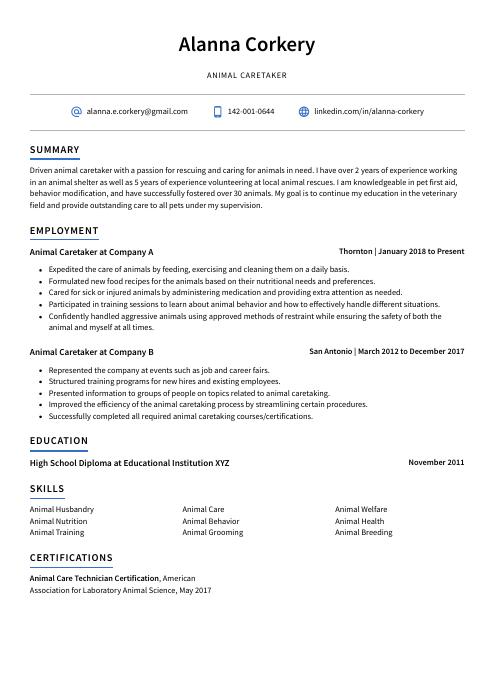 Axolotl
Axolotl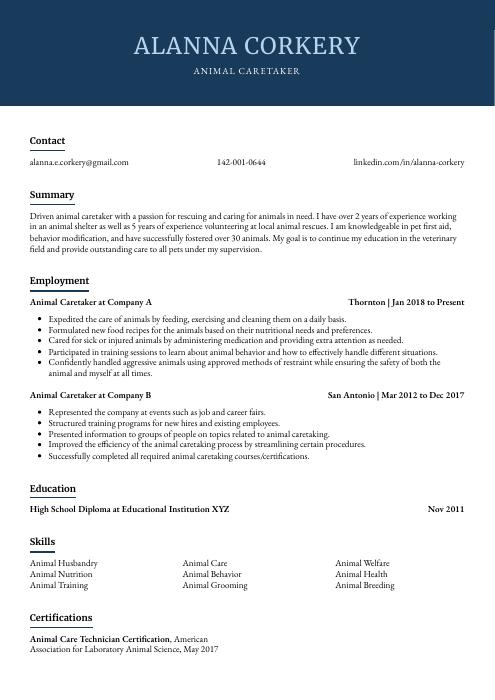 Bonobo
Bonobo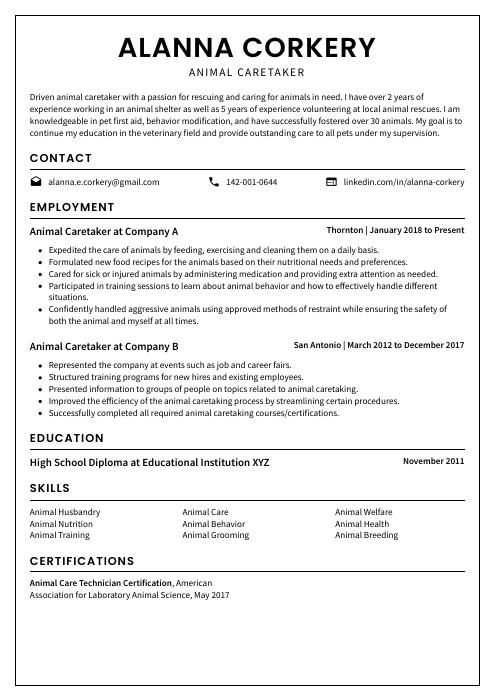 Cormorant
Cormorant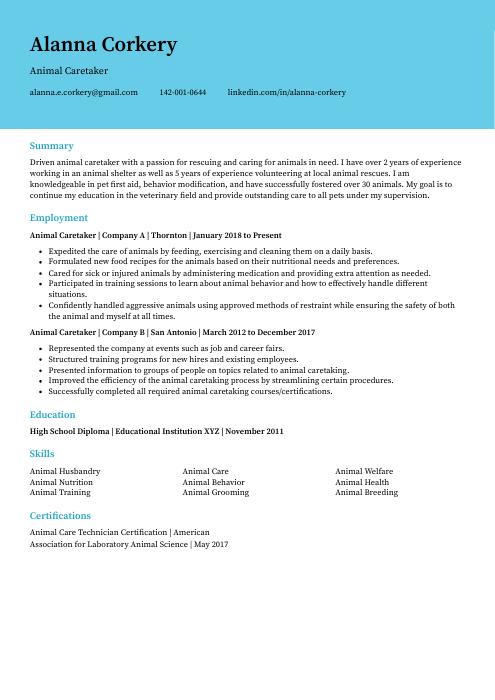 Dugong
Dugong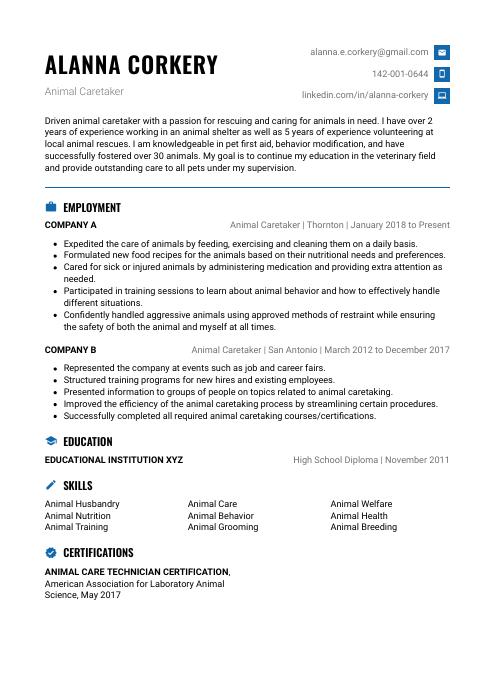 Echidna
Echidna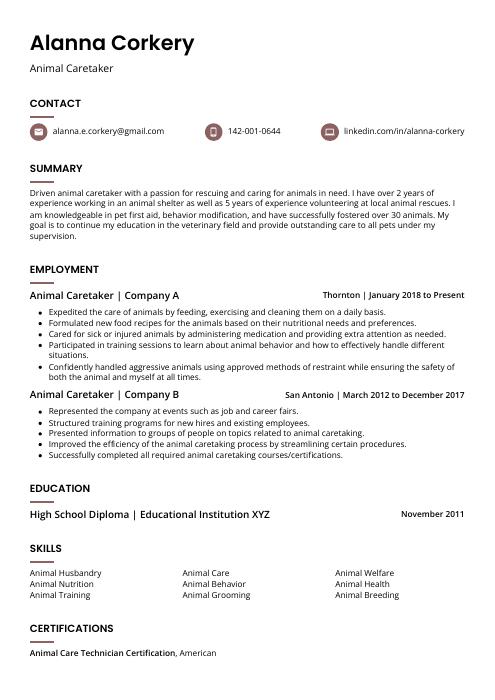 Fossa
Fossa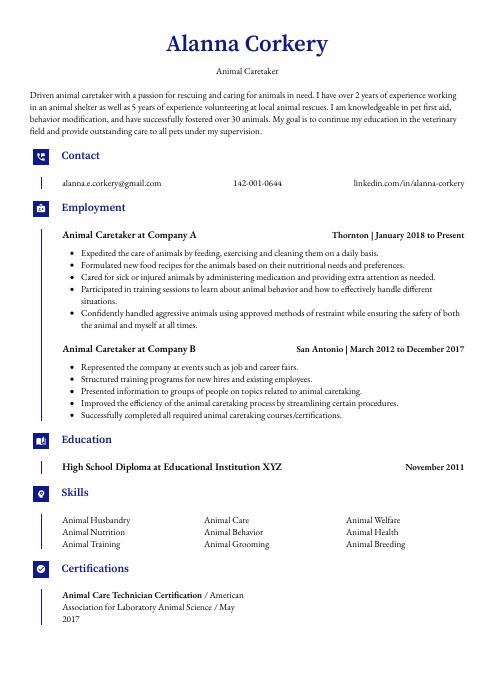 Gharial
Gharial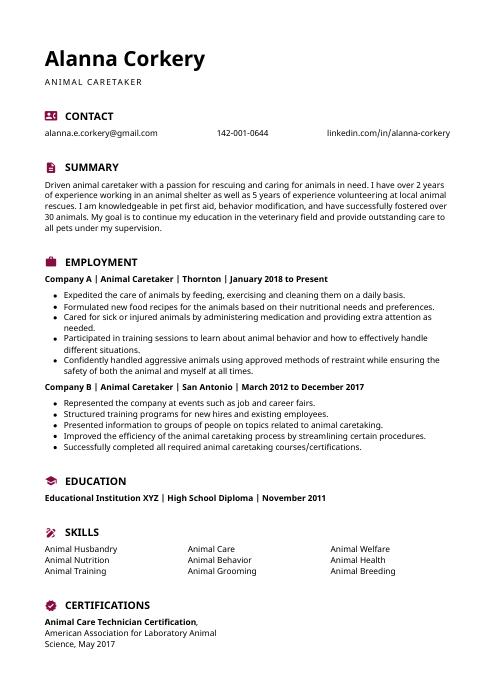 Hoopoe
Hoopoe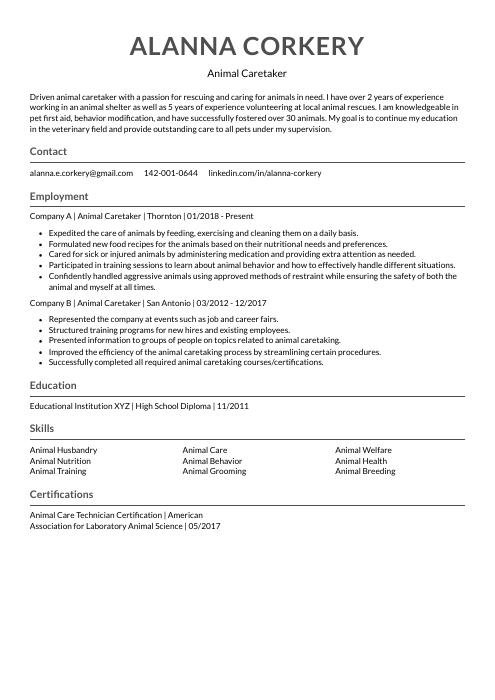 Indri
Indri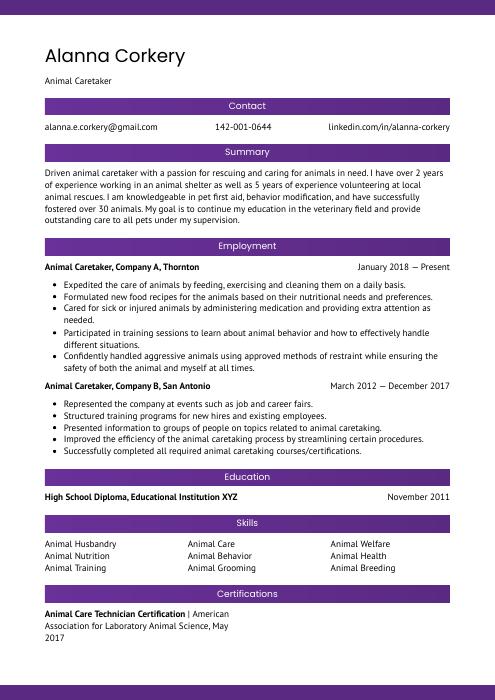 Jerboa
Jerboa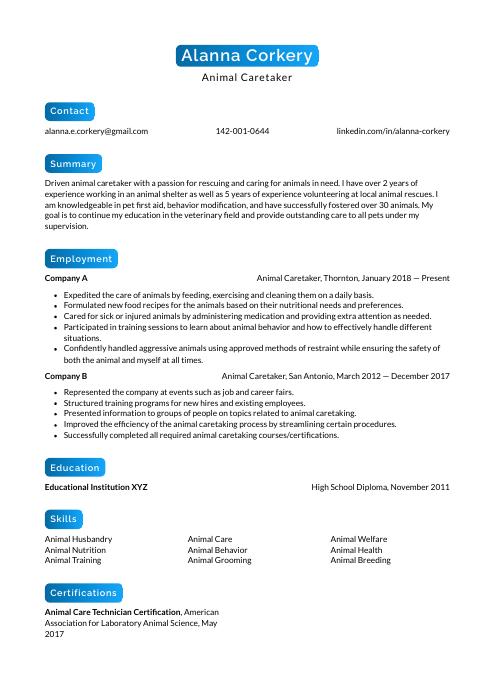 Kinkajou
Kinkajou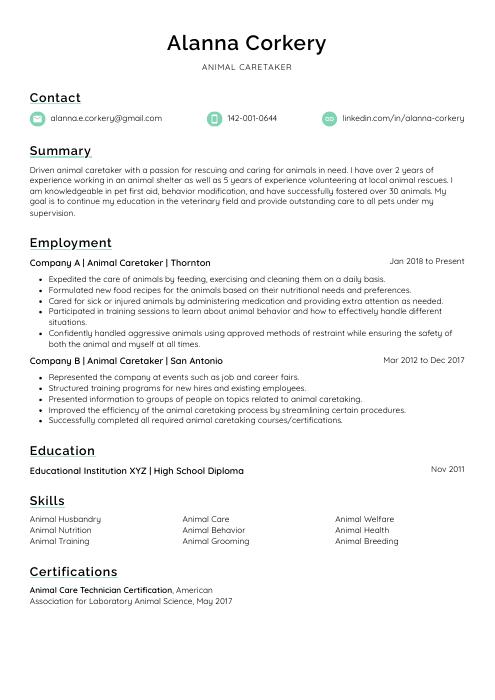 Lorikeet
Lorikeet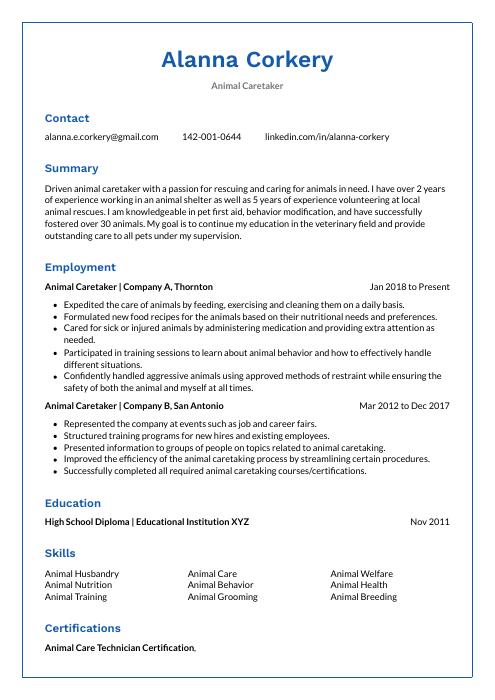 Markhor
Markhor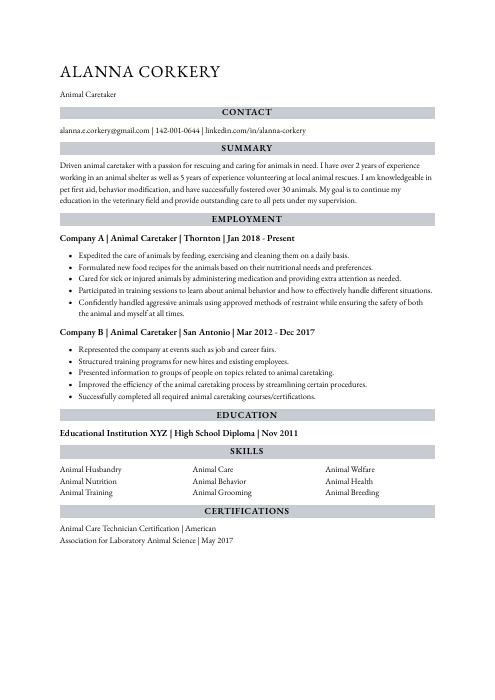 Numbat
Numbat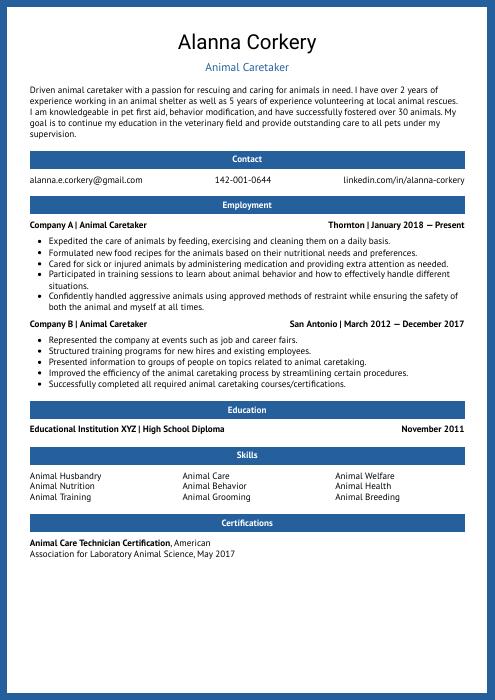 Ocelot
Ocelot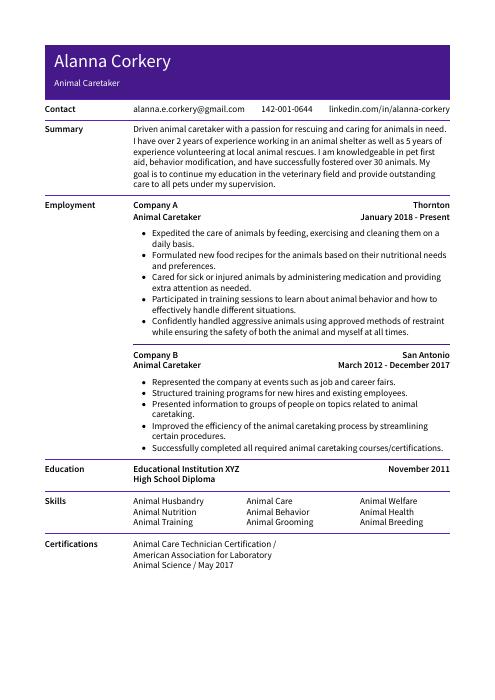 Pika
Pika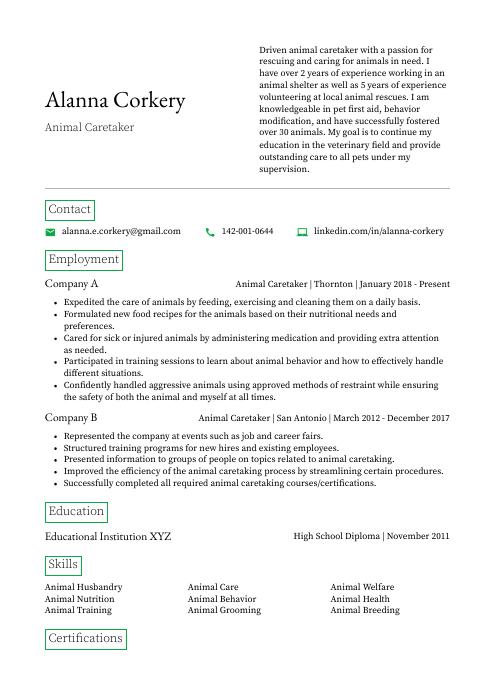 Quokka
Quokka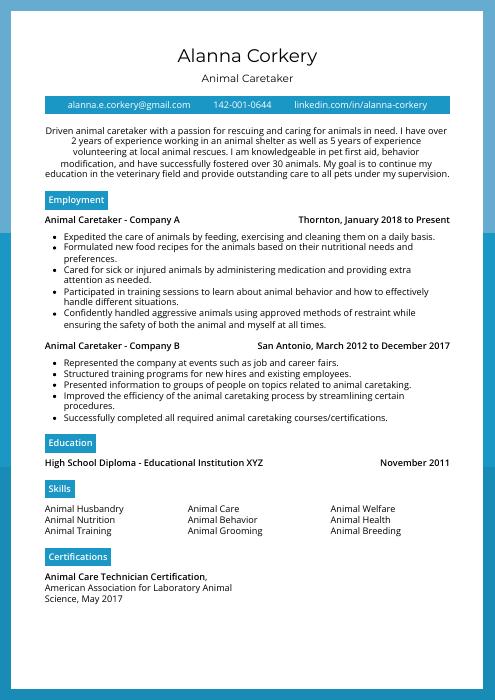 Rhea
Rhea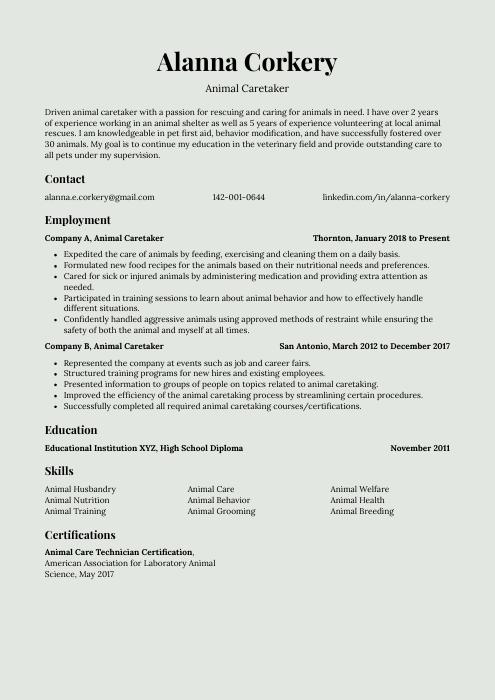 Saola
Saola Rezjumei
Rezjumei
